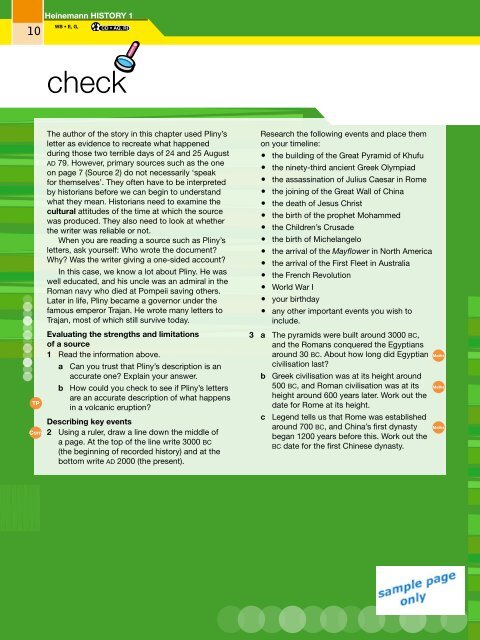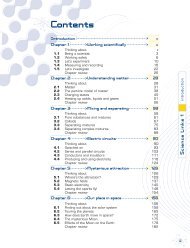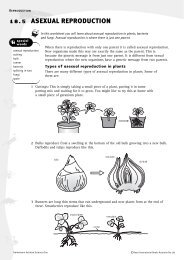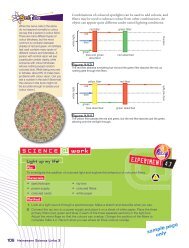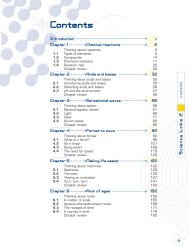Heinemann HISTORY 1 The author of the story in this chapter used ...
Heinemann HISTORY 1 The author of the story in this chapter used ...
Heinemann HISTORY 1 The author of the story in this chapter used ...
You also want an ePaper? Increase the reach of your titles
YUMPU automatically turns print PDFs into web optimized ePapers that Google loves.
10<br />
<strong>He<strong>in</strong>emann</strong> <strong>HISTORY</strong> 1<br />
WB • E, G, CD • AQ, RI<br />
check<br />
TP<br />
Com<br />
<strong>The</strong> <strong>author</strong> <strong>of</strong> <strong>the</strong> <strong>story</strong> <strong>in</strong> <strong>this</strong> <strong>chapter</strong> <strong>used</strong> Pl<strong>in</strong>y’s<br />
letter as evidence to recreate what happened<br />
dur<strong>in</strong>g those two terrible days <strong>of</strong> 24 and 25 August<br />
ad 79. However, primary sources such as <strong>the</strong> one<br />
on page 7 (Source 2) do not necessarily ‘speak<br />
for <strong>the</strong>mselves’. <strong>The</strong>y <strong>of</strong>ten have to be <strong>in</strong>terpreted<br />
by historians before we can beg<strong>in</strong> to understand<br />
what <strong>the</strong>y mean. Historians need to exam<strong>in</strong>e <strong>the</strong><br />
cultural attitudes <strong>of</strong> <strong>the</strong> time at which <strong>the</strong> source<br />
was produced. <strong>The</strong>y also need to look at whe<strong>the</strong>r<br />
<strong>the</strong> writer was reliable or not.<br />
When you are read<strong>in</strong>g a source such as Pl<strong>in</strong>y’s<br />
letters, ask yourself: Who wrote <strong>the</strong> document?<br />
Why? Was <strong>the</strong> writer giv<strong>in</strong>g a one-sided account?<br />
In <strong>this</strong> case, we know a lot about Pl<strong>in</strong>y. He was<br />
well educated, and his uncle was an admiral <strong>in</strong> <strong>the</strong><br />
Roman navy who died at Pompeii sav<strong>in</strong>g o<strong>the</strong>rs.<br />
Later <strong>in</strong> life, Pl<strong>in</strong>y became a governor under <strong>the</strong><br />
famous emperor Trajan. He wrote many letters to<br />
Trajan, most <strong>of</strong> which still survive today.<br />
Evaluat<strong>in</strong>g <strong>the</strong> strengths and limitations<br />
<strong>of</strong> a source<br />
1 Read <strong>the</strong> <strong>in</strong>formation above.<br />
a Can you trust that Pl<strong>in</strong>y’s description is an<br />
accurate one? Expla<strong>in</strong> your answer.<br />
b How could you check to see if Pl<strong>in</strong>y’s letters<br />
are an accurate description <strong>of</strong> what happens<br />
<strong>in</strong> a volcanic eruption?<br />
Describ<strong>in</strong>g key events<br />
2 Us<strong>in</strong>g a ruler, draw a l<strong>in</strong>e down <strong>the</strong> middle <strong>of</strong><br />
a page. At <strong>the</strong> top <strong>of</strong> <strong>the</strong> l<strong>in</strong>e write 3000 bc<br />
(<strong>the</strong> beg<strong>in</strong>n<strong>in</strong>g <strong>of</strong> recorded hi<strong>story</strong>) and at <strong>the</strong><br />
bottom write ad 2000 (<strong>the</strong> present).<br />
Research <strong>the</strong> follow<strong>in</strong>g events and place <strong>the</strong>m<br />
on your timel<strong>in</strong>e:<br />
• <strong>the</strong> build<strong>in</strong>g <strong>of</strong> <strong>the</strong> Great Pyramid <strong>of</strong> Khufu<br />
• <strong>the</strong> n<strong>in</strong>ety-third ancient Greek Olympiad<br />
• <strong>the</strong> assass<strong>in</strong>ation <strong>of</strong> Julius Caesar <strong>in</strong> Rome<br />
• <strong>the</strong> jo<strong>in</strong><strong>in</strong>g <strong>of</strong> <strong>the</strong> Great Wall <strong>of</strong> Ch<strong>in</strong>a<br />
• <strong>the</strong> death <strong>of</strong> Jesus Christ<br />
• <strong>the</strong> birth <strong>of</strong> <strong>the</strong> prophet Mohammed<br />
• <strong>the</strong> Children’s Crusade<br />
• <strong>the</strong> birth <strong>of</strong> Michelangelo<br />
• <strong>the</strong> arrival <strong>of</strong> <strong>the</strong> Mayflower <strong>in</strong> North America<br />
• <strong>the</strong> arrival <strong>of</strong> <strong>the</strong> First Fleet <strong>in</strong> Australia<br />
• <strong>the</strong> French Revolution<br />
• World War I<br />
• your birthday<br />
• any o<strong>the</strong>r important events you wish to<br />
<strong>in</strong>clude.<br />
3 a <strong>The</strong> pyramids were built around 3000 bc,<br />
and <strong>the</strong> Romans conquered <strong>the</strong> Egyptians<br />
around 30 bc. About how long did Egyptian<br />
civilisation last?<br />
b Greek civilisation was at its height around<br />
500 bc, and Roman civilisation was at its<br />
height around 600 years later. Work out <strong>the</strong><br />
date for Rome at its height.<br />
c Legend tells us that Rome was established<br />
around 700 bc, and Ch<strong>in</strong>a’s first dynasty<br />
began 1200 years before <strong>this</strong>. Work out <strong>the</strong><br />
bc date for <strong>the</strong> first Ch<strong>in</strong>ese dynasty.<br />
Maths<br />
Maths<br />
Maths
Chapter 1 POMPEII: <strong>in</strong>terpret<strong>in</strong>g <strong>the</strong> past<br />
11<br />
How long ago?<br />
Hi<strong>story</strong> can be divided <strong>in</strong>to four ma<strong>in</strong> periods that<br />
stretch back thousands <strong>of</strong> years.<br />
Period<br />
Prehistoric times<br />
Date bc (before Christ or ad<br />
(after Christ)<br />
Before c. 3000 bc — no<br />
written records exist although<br />
<strong>the</strong>re were visual records such<br />
as pa<strong>in</strong>t<strong>in</strong>gs and <strong>in</strong>formation<br />
was also passed on orally (by<br />
mouth)<br />
Ancient hi<strong>story</strong> c. 3000 bc to ad 500<br />
Middle Ages c. ad 500 to ad 1500<br />
Modern hi<strong>story</strong><br />
c. ad 1500 to <strong>the</strong> present<br />
<strong>The</strong> Pompeii <strong>story</strong> is based on two dates, one<br />
ancient and <strong>the</strong> o<strong>the</strong>r modern: <strong>the</strong> eruption <strong>of</strong> Mt<br />
Vesuvius <strong>in</strong> ad 79, and <strong>the</strong> excavation <strong>of</strong> Pompeii<br />
<strong>in</strong> 1863.<br />
Note:<br />
• BC means ‘before Christ’; AD stands for <strong>the</strong><br />
Lat<strong>in</strong> term ‘Anno Dom<strong>in</strong>i’ (Year <strong>of</strong> our Lord) and<br />
refers to <strong>the</strong> time after Christ’s death.<br />
• <strong>The</strong> abbreviation ‘c.’ <strong>in</strong> front <strong>of</strong> a date means<br />
‘circa’, or approximately.
<strong>He<strong>in</strong>emann</strong> <strong>HISTORY</strong> 1<br />
12<br />
WB • F, H, I, J CD • FG, MG, MC<br />
TRK • EW, EW, CT, AT<br />
glossary<br />
aqueduct man-made structure that carried water<br />
from mounta<strong>in</strong> streams to towns<br />
artefact a human-created object, small or large,<br />
such as a tool or a build<strong>in</strong>g<br />
archaeologist someone who uses scientific<br />
methods to uncover <strong>the</strong> past<br />
basilica a large church or temple, <strong>of</strong>ten built with<br />
rows <strong>of</strong> columns<br />
cultural relat<strong>in</strong>g to <strong>the</strong> lifestyle <strong>of</strong> a group <strong>of</strong> people<br />
at a given time<br />
lava molten rock erupt<strong>in</strong>g from beneath <strong>the</strong> Earth’s<br />
surface<br />
Jupiter <strong>the</strong> chief god <strong>of</strong> <strong>the</strong> Romans<br />
primary source evidence from <strong>the</strong> time <strong>of</strong> <strong>the</strong><br />
event, such as an eyewitness account, or an<br />
object, build<strong>in</strong>g, or skeletal rema<strong>in</strong>s<br />
pumice molten rock which is filled with air as it is<br />
blasted <strong>in</strong>to <strong>the</strong> sky<br />
secondary source evidence such as a book or<br />
pa<strong>in</strong>t<strong>in</strong>g created after <strong>the</strong> time <strong>of</strong> an event, by<br />
someone not at <strong>the</strong> event<br />
sibyl a woman <strong>in</strong> ancient times who was believed<br />
to be a mouthpiece <strong>of</strong> <strong>the</strong> gods<br />
Temple <strong>of</strong> Venus a large temple <strong>in</strong> Pompeii<br />
dedicated to <strong>the</strong> Roman goddess Venus<br />
Vesta Roman goddess <strong>of</strong> <strong>the</strong> fireplace, who<br />
watched over <strong>the</strong> family<br />
Vulcan Roman god <strong>of</strong> fire


